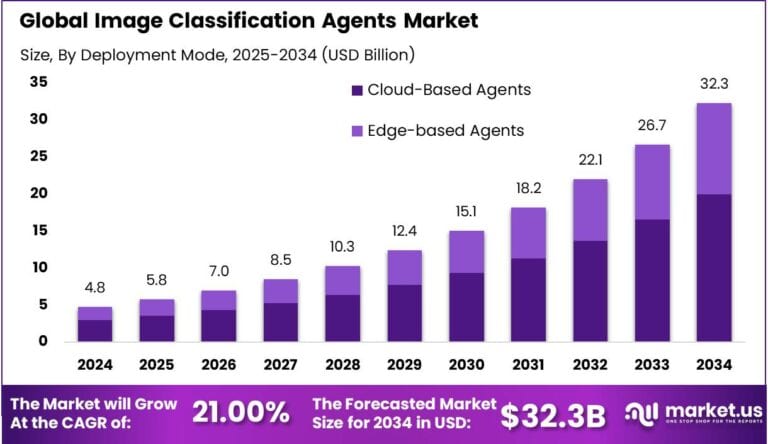Table of Contents
Introduction
The global image classification agents market is expected to grow from USD 4.8 billion in 2024 to USD 32.3 billion by 2034, exhibiting a CAGR of 21%. In 2024, North America dominated with over 36% market share, generating approximately USD 1.7 billion. The U.S. segment was valued at USD 1.6 billion, growing at a CAGR of 18.4%. Growth is driven by the increasing adoption of AI-powered image recognition technologies across sectors such as healthcare, automotive, retail, and security, fueled by advances in machine learning and deep learning algorithms.

How Tariffs Are Impacting the Economy
Tariffs on hardware components, including GPUs, sensors, and processors essential for image classification agents, elevate production costs for technology providers. These increased costs often lead to higher prices for end-users, potentially slowing technology adoption and innovation.
➤ Discover how our research uncovers business opportunities @ https://market.us/report/image-classification-agents-market/free-sample/
(Use corporate mail ID for quicker response)
Tariffs disrupt global supply chains by forcing companies to seek alternative suppliers or relocate manufacturing, resulting in higher operational expenses and longer lead times. Retaliatory tariffs exacerbate trade tensions, adding uncertainty that hampers investments in R&D and cross-border collaborations. Collectively, these factors slow down the deployment of advanced AI technologies, limiting productivity gains and economic growth across industries reliant on image classification.

Impact on Global Businesses
Businesses in the image classification market face increased costs due to tariffs on critical components, affecting profitability and scaling. Supply chain shifts to diversify suppliers or localize manufacturing add complexity and capital requirements. Industries like healthcare, automotive, and retail experience delayed AI integration, impacting operational efficiency and customer experience. Emerging markets reliant on imports face affordability challenges, hindering market penetration. Companies must optimize supply chains, invest in cloud and software solutions, and focus on innovation to maintain competitiveness amid tariff-induced volatility.
Strategies for Businesses
Companies mitigate tariff impacts through supplier diversification and investing in regional manufacturing capabilities. Transitioning to cloud-based AI platforms reduces hardware dependency and improves scalability. Utilizing predictive analytics helps forecast tariff changes and optimize inventory management. Strategic partnerships with local players enhance supply chain resilience. Emphasizing automation and process optimization lowers operational costs. Active engagement with policymakers aims to influence favorable trade policies. Agility, innovation, and collaboration remain key to navigating tariff challenges successfully.
➤ Get full PDF access here @ https://market.us/purchase-report/?report_id=149023
Key Takeaways
- Image classification agents market expected to grow at 21% CAGR through 2034
- Tariffs increase production costs and disrupt supply chains
- Deployment delays affect efficiency and customer experience across sectors
- Supply diversification and cloud adoption mitigate tariff effects
- Predictive analytics supports proactive tariff risk management
Analyst Viewpoint
The image classification agents market is poised for strong growth driven by AI adoption across multiple industries. Tariffs present cost and supply challenges but also accelerate innovation in cloud and software-centric solutions. Market leaders focus on scalability, interoperability, and strategic partnerships to maintain agility. The future outlook remains positive as digital transformation and demand for AI-driven insights continue to expand globally.
Regional Analysis
North America leads with a 36% share in 2024, driven by advanced AI research, high technology adoption, and strong enterprise demand. The U.S. dominates regional growth with significant investments in AI-powered healthcare, automotive, and retail applications. Europe follows with steady growth supported by innovation hubs and regulatory frameworks. Asia-Pacific shows rapid potential fueled by digitalization and increasing AI deployment in emerging economies. Regional disparities arise from technological maturity, policy support, and investment levels.
➤ Discover More Trending Research
- Digitalization of Power Distribution Market
- Sports Broadcasting Technology Market
- Real Estate Loan Market
- Counter-Drone Market
Business Opportunities
Growing demand for AI-powered image recognition in healthcare diagnostics, autonomous vehicles, retail analytics, and security presents significant opportunities. Cloud-based and edge AI solutions offer scalable deployment models. Emerging markets provide expansion potential due to rising digital adoption. Collaborations with technology providers and industry verticals facilitate customized solutions. Additionally, integrating image classification with IoT and big data analytics opens new avenues for innovation and monetization.
Key Segmentation
By Component
- Hardware
- Software
- Services
By Technology
- Machine Learning
- Deep Learning
By Application
- Healthcare
- Automotive
- Retail
- Security and Surveillance
- Others
By Region
- North America
- Europe
- Asia-Pacific
- Rest of the World
Key Player Analysis
Leading companies invest heavily in developing advanced AI algorithms and scalable cloud platforms. Strategic alliances with enterprises and technology vendors expand market reach. Emphasis on interoperability, data security, and regulatory compliance strengthens competitive positioning. Market leaders focus on user experience and continuous innovation. Regional expansions through localized services bolster growth. Customer-centric solutions and R&D investments sustain leadership in a fast-evolving market.
Recent Developments
In 2025, several providers launched enhanced deep learning image classification platforms with real-time analytics. Partnerships with healthcare and automotive firms accelerated AI adoption. Advances in edge computing improved deployment flexibility.
Conclusion
The image classification agents market is on a robust growth path fueled by AI integration and digital transformation. Tariff challenges drive innovation and supply chain diversification. Continued investments in cloud and AI technologies will ensure sustained market expansion.
Discuss your needs with our analyst
Please share your requirements with more details so our analyst can check if they can solve your problem(s)



